
Classic 19th Century Artificial fly-The Triumph
An
artificial fly or
fly lure is a type of
fishing lure, usually used in the sport of
fly fishing (although they may also be used in other forms of angling). In general, artificial flies are the
bait which fly fishers present to their
target species of fish while fly fishing. Artificial flies are constructed by
fly tying, in which
furs,
feathers,
thread or any of very many other materials are tied onto a
fish hook.
[1] Artificial flies may be constructed to represent all manner of potential
freshwater and
saltwater fish
prey to include
aquatic and
terrestrial insects,
crustaceans,
worms,
baitfish,
vegetation,
flesh,
spawn, small
reptiles,
amphibians,
mammals and
birds, etc. Effective artificial fly patterns are said to be
killing flies because of their ability to put fish in the
creel for the fly fisher. There are thousands of artificial fly patterns, many of them with descriptive and often idiosyncratic names.
Construction
Fly tying is a common practice in fly fishing, considered by many anglers an important part of the fly fishing experience. Many fly fishers tie their own flies, either following patterns in books, natural insect examples, or using their own imagination. The technique involves attaching small pieces of
feathers,
animal fur, and other materials on a
hook in order to make it attractive to fish. This is made by wrapping thread tightly around the hook and tying on the desired materials. A fly is sized according to the width of the hook gap; large or longer flies are tied on larger, thicker, and longer hooks.
Types
Generally, fly patterns are considered either "imitations" or "attractors". Imitations seek to deceive fish through the life-like imitation of insects on which the fish may feed. Imitators do not always have to be precisely realistic in appearance; they may derive their lifelike qualities when their fur or feathers are immersed in water and allowed to move in the current. Attractors, which are often brightly colored, seek to draw a strike by arousing an aggression response in the fish. Famous attractors are the
Stimulator and
Royal Wulff flies.
History

First known illustration of a fishing fly from 4th. edition (1652) of
John Dennys's
The Secrets of Angling, first published in 1613, probably the earliest poetical English treatise on Angling.,
[2][3]
The first literary reference to flies and fishing with flies was in Ælian’s Natural History probably written about 200 A.D. That work discussed a Macedonian fly.
The Treatyse on Fysshynge with an Angle was published (1496) within
The Boke of St. Albans attributed to Dame
Juliana Berners. The book contains, along with instructions on rod, line and hook making, dressings for different flies to use at different times of the year. Probably the first use of the term
Artificial fly came in Izaac Walton's
The Compleat Angler (1653),
[4]
Oh my good Master, this morning walk has been spent to my great pleasure and wonder: but I pray, when shall I have your direction how to make Artificial flyes, like to those that the Trout loves best?[5]

Frontpiece from Bowlker's Art of Angling (1854) showing a variety of artificial flies
[6]
The 1652 4th. edition of
John Dennys's
The Secrets of Angling , first published in 1613, contains the first known illustration of an artificial fly.
By the early 19th century, the term
artificial fly was being routinely used in angling literature much like this representative quote from Thomas Best's
A Concise Treatise on the Art of Angling (1807) to refer to all types of
flies used by fly fishers.
The art of artificial fly-fishing, certainly has the pre-eminence over the other various methods that are used to take fishes in the art of angling[7]
Although the term
fly was a reference to an imitation of some flying insect, by the mid-19th century the term fly was being applied to a far greater range of imitation.
[original research?]
The term fly is applied by sea fishermen to a certain arrangement of feathers, wax, etc., which I am about to describe the manufacture of, and which may be used with considerable success in mackerel, basse, and pollack fishing. I am not disposed to think, however, that such baits are ever mistaken by the fish which they are intended to capture for flies; but the number used, the way in which they are mounted, viz., several on one trace, and the method of their progress through the water, rather leads me to the belief that they are mistaken for a number of small fry, and treated accordingly.[8]
Imitation

Illustration of a large Pike fly (1865)
[9]
A major concept in the sport of fly fishing is that the fly
imitates some form of fish prey when presented to the fish by the angler. As aquatic insects such as
Mayflies,
Caddisflies and
Stoneflies were the primary prey being imitated during the early developmental years of fly fishing, there were always differing schools of thought on how closely a fly needed to imitate the fish's prey.
In the mid to late 19th century, those schools of thought, at least for trout fishing were: the
formalists (imitation matters) and the
colourists (color matters most).
[10] Today, some flies are called
attractor patterns because in theory, they do not resemble any specific prey, but instead
attract strikes from fish. For instance, Charles Jardine, in his 2008 book "Flies, Ties and Techniques," speaks of imitators and attractors, categorizing the Royal Wulff as an attractor and the Elk Hair Caddis as an imitator, whereas "... in sea trout and steelhead fishing there is a combination of imitation and attraction involved in fly construction".
[11] Paul Schullery in
American Fly Fishing - A History (1996) explains however that although much has been written about the imitation theories of fly design, all successful fly patterns must imitate something to the fish, and even a perfect imitation
attracts strikes from fish. The huge range of fly patterns documented today for all sorts of target species-
trout,
salmon,
bass and
panfish,
pike, saltwater, tropical exotics, etc. are not easily categorized as merely
imitative,
attractors or something else.
[12]
Contemporary fly types and illustrative examples
The categorization of artificial flies has evolved considerably in the last 200 years as writers, fly tiers and fishing equipment retailers expound and promote new ideas and techniques. Additionally, as the popularity of fly fishing expanded globally to new and exotic target species, new flies and genera of flies came into being. There are many subtypes in some of these categories especially as they apply to
trout flies. As well, any given pattern of artificial fly might well fit into multiple categories depending on its intended use. The following categorization with illustrative examples is derived from the following major artificial fly merchants offerings.
- Orvis - An American Fly Fishing Retailer in business since 1856 [13]
- Farlows of London - A British Fly Fishing Retailer in business since 1840[14]
- Umpqua Feather Merchants - An American artificial fly manufacturer and wholesaler in business since 1972[15]
Dry flies
Dry flies are designed to be
buoyant, or to float on the surface of the water. Dry flies typically represent the adult form of an aquatic or terrestrial insect. Dry flies are generally considered freshwater flies.
[16]
| Dry flies |
|
|
The Adams - A typical dry fly
|
|
Wet flies
Wet flies are designed to sink below the surface of the water. Wet flies have been tied in a wide variety of patterns to represent larva, nymphs, pupa, drowned insects, baitfish and other underwater prey. Wet flies are generally considered freshwater flies.
[17]
| Wet flies |
|
|
Grizzly King - A classic wet fly
|
|
Nymph flies
Nymphs are designed to resemble the immature form of aquatic insects and small
crustaceans. Nymph flies are generally considered freshwater flies.
[18]
| Nymphs |
|
|
Brook's Montana Stonefly nymph
|
|
Emerger flies
Emergers are designed to resemble the not quite mature hatching aquatic insect as it leaving the water to become an adult insect. Emerger flies are generally considered freshwater trout flies.
[19]
Streamer flies
Streamers are designed to resemble some form of baitfish or other large aquatic prey. Streamer flies may be patterned after both freshwater and saltwater prey species. Streamer flies are a very large and diverse category of flies as streamers are effective for almost any type of
gamefish.
[20]
| Streamer flies |
|
|
Mickey Finn - A classic streamer pattern
|
|
|
Schenk's White Minnow - A popular eastern chub imitation |
|
Terrestrial flies
Terrestrials are designed to resemble non-aquatic insects, crustaceans and worms that could fall prey to feeding fish after being blown or falling onto the water.,
[21][22]
| Terrestrial flies |
|
|
Dave's Hopper, a terrestrial dry fly imitating a common grasshopper
|
|
Bass and panfish flies, bugs and poppers
Bass and
panfish flies, bugs and poppers are generally designed to resemble both surface and sub-surface insect, crustacean, baitfish prey consumed by warm-water species such as
Largemouth bass or
bluegill. This genus of flies generally includes patterns that resemble small mammals, birds, amphibians or reptiles that may fall prey to fish, or in the case of panfish flies, small aquatic insects or crustaceans.
| Bass and panfish flies |
|
|
Bluegill streamer EP style
|
|
Pike and musky flies
Pike and musky flies are generally designed to resemble both surface and sub-surface crustacean, baitfish prey consumed by species of the genus
Esox such as
Northern Pike or
Muskellunge. This genus of flies are larger than bass flies and generally includes patterns that resemble baitfish and small mammals, birds, amphibians or reptiles that may fall prey to fish.
[23]
[edit] Carp flies
Carp flies are designed to resemble various vegetative sources of food that
carp feed on such as berries, seeds and flowers that may fall into the water.
[24]
Salmon flies
Salmon flies are a traditional class of flies tied specifically to fly fish for
Atlantic Salmon. Some salmon flies may be classified as lures while others may be classified as dry flies, such as the bomber. Salmon flies are also tied in
classic and
contemporary patterns.
[25]
| Salmon flies |
|
|
Durham Ranger - a Classic Salmon fly
|
|
|
Green Highlander - a Classic Salmon fly
|
|
Steelhead and Pacific salmon flies
Steelhead and
Pacific salmon flies are designed for catching
anadromous steelhead trout and pacific salmon in western North American and Great Lakes rivers.
Egg flies
Egg flies are all designed to resemble the spawn of other fish that may be encountered in a river and consumed by the target species.
Flesh flies
Flesh flies are designed to resemble the rotting flesh of pacific salmon encountered in a river and consumed by the target species.
Saltwater flies
Saltwater flies are a class of flies designed to represent a wide variety of inshore, offshore and
estuarial saltwater baitfish, crustacean and other saltwater prey. Saltwater flies generally are found in both sub-surface and surface patterns.
[26]
| Saltwater flies |
|
|
White Lefty's Deceiver - An all purpose saltwater baitfish imitation
|
|
|
Cockroach Deceiver (Lefty Kreh)
|
|
Bonefish flies
Bonefish flies are a special class of saltwater flies used to catch
Bonefish in shallow water. Bonefish flies generally resemble small crabs, shrimp or other crustaceans.
[27]
| Bonefish flies |
|
|
Crazy Charlie - A popular bonefish fly
|
|
Tarpon flies
Tarpon flies are a special class of saltwater flies used to catch
Tarpon in both inshore and offshore waters. Tarpon flies generally represent small baitfish commonly preyed upon by tarpon.
[27]
| Tarpon flies |
|
|
Stu Apte Classic Tarpon Fly
|
|
Striped bass flies
Striped bass flies are a special class of freshwater-saltwater fly used to catch
Striped Bass in freshwater, inshore and offshore waters. Striped bass flies generally represent small baitfish commonly preyed upon by striped bass.






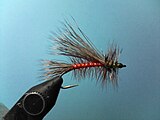

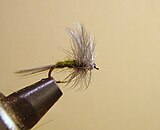
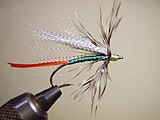




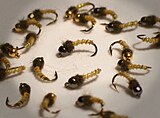

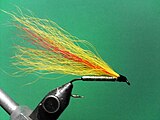

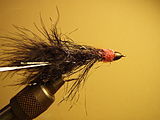


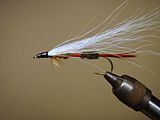



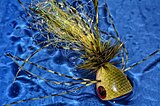



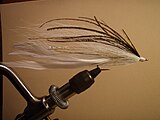

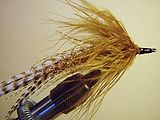
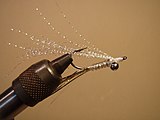
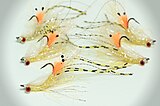
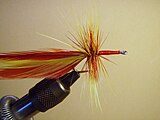
No comments:
Post a Comment